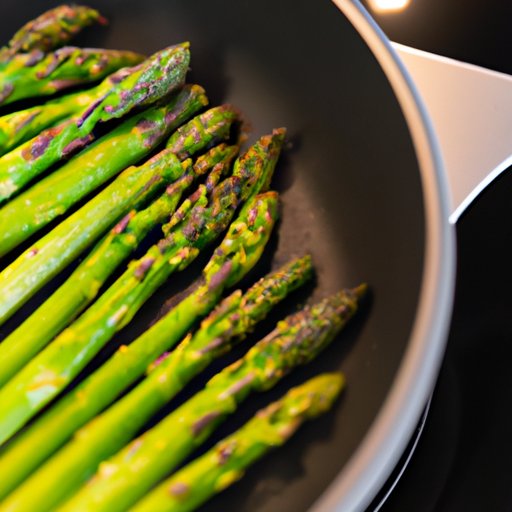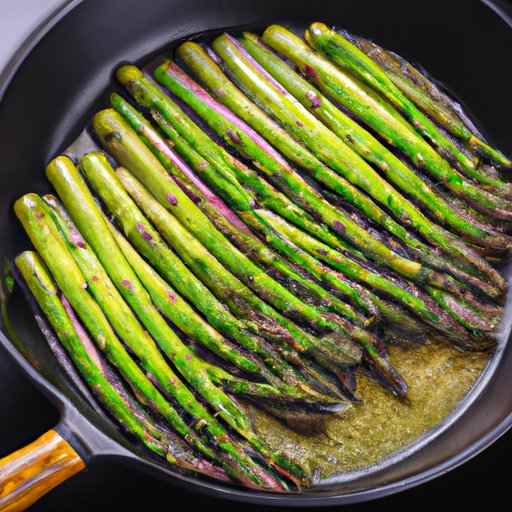
Introduction
Asparagus is a staple vegetable in many households, and it can be cooked in different ways. One of the easiest and most popular ways to cook asparagus is on the stovetop. Though it may sound simple, cooking asparagus perfectly on the stovetop requires a bit of finesse. This guide will provide you with everything you need to cook delicious asparagus on the stove, from simple and quick techniques to unique recipes for your family and friends.
7 Simple Steps to Delicious Stovetop Asparagus
Before we dive into the different cooking methods, let’s start with the basics. Here are seven simple steps to perfectly cooked asparagus on the stovetop:
- Wash the asparagus in cold water and dry them.
- Cut off any tough or woody ends of the asparagus. The best way to know the right spot on each stalk is to bend the asparagus gently. It should snap off naturally at the point where the tender stalk meets the tougher end.
- Heat a large skillet or sauté pan over medium-high heat with one tablespoon of olive oil or butter.
- Add the asparagus to the pan and season with salt and pepper, or other seasonings of your choice, such as garlic powder or lemon zest. Use tongs to toss the asparagus so that they are evenly coated in the seasoning.
- Cover the skillet and cook for five to eight minutes, or until the asparagus is tender yet slightly crisp. Shake the pan occasionally to ensure even cooking, and adjust the heat as needed.
- Remove from heat and add a squeeze of lemon juice, Parmesan cheese, or other toppings of your choice.
- Serve hot or cold.
Master the Art of Stovetop Asparagus with these Dynamic Cooking Techniques
Now that you have mastered the basic steps, it’s time to experiment with different cooking methods. Here are three dynamic cooking techniques to create unique flavors:
Sautéing
Sautéing asparagus is a fast and easy way to cook it to perfection. Here’s how:
- Heat a skillet over medium heat.
- Once the skillet is hot, add two tablespoons of olive oil or butter.
- Add the asparagus to the pan and season with salt and pepper or other seasonings according to your preference.
- Sauté the asparagus until it’s browned and tender, shaking the pan occasionally to cook them evenly.
- Remove from heat and garnish with parsley or other herbs according to your taste.
Blanching
Blanching is an ideal way to cook asparagus to retain its color and crispness. Here’s how:
- Boil six cups of water in a large pot.
- Add one tablespoon of salt to the boiling water.
- Place the asparagus in the water and cook for two to three minutes until it’s tender but still firm.
- Remove from heat immediately and transfer to a large bowl filled with ice water.
- Let it sit for a few minutes until it’s thoroughly cooled.
- Remove from the ice water and pat them dry with a paper towel.
- Season with salt, pepper, and olive oil or other sauces according to your preference.
Roasting
Roasting gives asparagus a rich taste, making it perfect for dinner parties and weekend get-togethers. Here’s how:
- Preheat the oven to 425°F.
- Wash and dry the asparagus stalks.
- Trim off the woody ends of the asparagus, then drizzle them with olive oil. Use your hands to mix the asparagus with the olive oil, ensuring all the stalks are coated.
- Place the asparagus on a baking sheet, spreading the stalks out in an even layer.
- Sprinkle salt, pepper, or other preferred seasonings over the asparagus.
- Roast the asparagus in the preheated oven for 12 to 15 minutes.
- Remove the asparagus from the oven and add some toppings of your choice, such as lemon juice, parmesan cheese, or herbs.
Light and Bright: Unique Recipes for Cooking Asparagus on the Stove
Here are a few ideas to experiment with unique flavors when cooking asparagus on the stove:
Asparagus with Lemon and Parmesan
This is a simple yet delicious recipe that works well as a side dish or a light main course.
- Ingredients:
- 1 pound asparagus, washed and trimmed
- 2 tablespoons olive oil
- 2 cloves garlic, minced
- 1 tablespoon lemon zest, freshly grated
- 2 tablespoons lemon juice
- 1/2 cup Parmesan cheese, freshly grated
- Salt and pepper to taste
- Instructions:
- Heat the olive oil in a large skillet over medium-high heat.
- Add garlic and lemon zest, and sauté for 30 seconds.
- Add asparagus and stir well to coat it with the garlic and lemon flavor.
- Cook the asparagus for 5-8 minutes, or until tender yet still crisp.
- Stir in the lemon juice and top with grated Parmesan cheese before serving.
From Blanching to Braising: A Guide to Cooking Asparagus on the Stovetop
Here are some more methods to cook asparagus on the stove:
Braising
Braising asparagus is a great way to impart deep, rich flavors. Here’s how:
- Heat the olive oil or butter in a large pan over medium-high heat.
- Add the asparagus and cook for about 5 minutes until it turns brown.
- Remove the asparagus to a plate. Add 1/2 cup water and 1/2 cup white wine to the pan and scrape the bottom to loosen any brown bits.
- Let the liquid come to a simmer and add the asparagus back to the pan.
- Simmer for 10-15 minutes, or until the sauce becomes thick and syrupy.
- Serve hot, garnished with chopped herbs or lemon zest.
Grilling
Grilled asparagus is a perfect summer dish, and it’s easy to cook on the stovetop grill pan as well. Here’s how:
- Preheat a stovetop grill pan over medium-high heat.
- Brush the grill pan with olive oil or butter.
- Add the asparagus in a single layer and grill for 5-6 minutes, or until they start to turn brown on one side.
- Flip the asparagus and grill for another 3-4 minutes until browned and tender.
- Remove from the heat and let it rest for 5 minutes.
- Add your favorite toppings, such as feta cheese, olives, or herbs.

Secret Tips from Top Chefs for Perfectly Cooked Stovetop Asparagus Every Time
Here are some bonus tips from top chefs to cook the perfect asparagus:
- Season asparagus lightly with salt during cooking to avoid over-salting.
- Slicing asparagus into thin ribbons or peeling the asparagus with a vegetable peeler before cooking can add texture and flavor.
- Grilling asparagus over a charcoal fire or gas grill will add a subtle smoky flavor.
- Always blanch asparagus spears in boiling water before freezing, so they retain their green color and crisp texture.
- If you love lemon flavor, add lemon zest to the cooking oil. The zest will release its oils into the oil, giving your asparagus a citrusy taste.
Effortlessly Healthy: Quick and Easy Stovetop Asparagus Recipes for Busy Days
Here are two quick, easy, and healthy asparagus recipes that you can make quickly on the stove:
Asparagus and Egg Skillet
This is a quick and delicious dish that works great for breakfast, lunch, or dinner.
- Ingredients:
- 1 pound asparagus, washed and trimmed
- 4 eggs
- 2 tablespoons olive oil
- Salt and pepper to taste
- Instructions:
- Heat the olive oil in a large skillet over medium-high heat.
- Add asparagus to the pan and sauté until it’s tender yet still crisp.
- Spread out the asparagus in the pan and crack four eggs on top of the asparagus.
- With a spatula, gently break the yolks and distribute the whites throughout the dish.
- Sprinkle salt and pepper over the eggs and asparagus.
- Cover the skillet and cook until the eggs are set, about 3-5 minutes.
- Serve hot.
Stir-fry Asparagus and Mushrooms
Stir-frying is a quick and easy way to cook asparagus, and it’s a perfect dish for busy weeknights.
- Ingredients:
- 1 pound asparagus, washed and trimmed
- 1/2 pound button mushrooms, sliced
- 2 cloves garlic, minced
- 2 tablespoons olive oil
- 1 tablespoon soy sauce
- 1 tablespoon honey
- Salt and pepper to taste
- Instructions:
- Heat the olive oil in a large skillet over high heat.
- Add garlic and mushrooms, and stir constantly for 2-3 minutes until the mushrooms start to brown.
- Add the asparagus and continue to stir-fry for 3-4 minutes until it’s tender yet still crisp.
- Add soy sauce and honey to the pan and toss them well.
- Season with salt and pepper according to your taste.
- Serve hot.
How to Cook Asparagus on the Stovetop Without Losing Its Nutritional Value
Asparagus is rich in vitamins, minerals, and dietary fiber, and cooking can reduce its nutritional value. Here’s how to cook asparagus while preserving its nutrients on the stovetop:
- Don’t overcook asparagus. It should be tender, but still crisp.
- Keep the cooking time to a minimum. The longer you cook it, the more nutrients it loses.
- Try cooking techniques that preserve the delicate texture and flavor of asparagus, such as blanching or sautéing.
Conclusion
Cooking asparagus on the stovetop is a simple yet satisfying way to enjoy this versatile vegetable. With the tips, techniques, and recipes we’ve shared, you’ll be able to create fresh and delicious asparagus dishes that everyone will love. Whether you’re preparing a quick and healthy dinner for a busy weeknight or a luxurious side dish for a special occasion, now you know how to perfectly cook asparagus on the stovetop.




